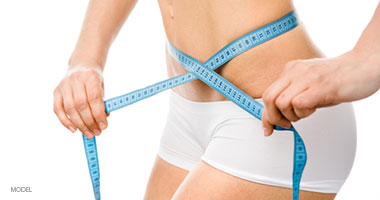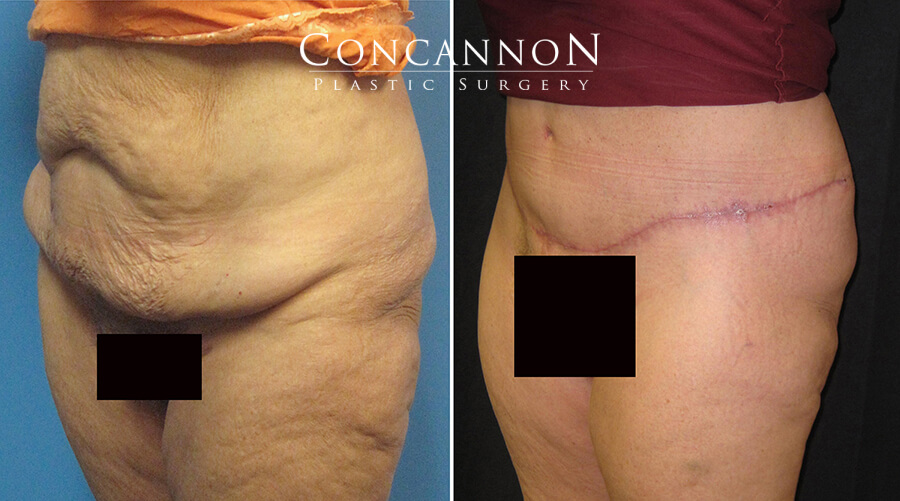
Following significant weight loss due to a bariatric surgery (also known as gastric bypass surgery, stomach stapling, weight loss surgery, and obesity surgery) a person can be left with a tremendous amount of excess hanging skin throughout many areas of the body that cannot shrink back to the person’s new body shape. Women and men often elect to have various cosmetic procedures to help them achieve the body shape that they seek. Due in part to the lack of elasticity of the remaining skin, excessive amounts of skin can accumulate and hang in various areas, including the face, neck, breasts, upper and lower abdomen, flanks, armpit (axilla), back, buttocks, arms, and thighs. Besides being physically undesirable, this excess skin can cause hygienic problems, skin irritation, skin breakdown and pain, and can lead to problems in finding clothes that can fit properly.

General Information
To address these problems, plastic surgery has become the most popular and effective solution for individuals who have lost significant weight. Facial and body contouring cosmetic procedures can help a patient obtain the best possible body shape that is hidden underneath the excess skin that remains after one’s goal weight has been reached. As people who have lost a lot of weight typically have excess skin problems throughout many areas of their body and face, it is common for a patient to have several different cosmetic procedures to address all the problem areas. Cosmetic procedures that patients have after a bariatric/gastric bypass surgery include:
- abdominoplasty (tummy tuck)
- mastopexy (breast lift)
- breast augmentation
- facial procedures (facelift, eyelid surgery, cervicoplasty/neck lift, forehead lift)
- thigh lift
- brachioplasty (arm lift)
- buttock lift
- male breast reduction (for gynecomastia)
- lower body lift (belt lipectomy)
Photo Gallery
Vew the results of previous patients on
Dr. Concannon’s extensive photo gallery
Additional Information
While it would be appealing to have all the desired procedures done at once, due to safety issues only 1 or 2 different procedures are typically performed at a time. Once recovery is complete, the outcome can be extremely rewarding to the patient in physical, emotional, lifestyle, and functional respects.
Following significant weight loss a person is typically left with large amounts of hanging skin in the upper and lower abdomen as well as loose abdominal wall muscles. To address these problems, a tummy tuck (abdominoplasty) can be performed to remove the excess skin and tighten the abdominal muscles. The excess amount of skin is not only physically unappealing to post-weight loss patients, but it can lead to considerable hygienic problems. Because moisture can accumulate between the abdominal folds of excess skin, this can lead to a skin condition called intertriginous dermatitis whereby the rubbing of the skin folds leads to an inflammation. Due to excess skin, a person can experience skin redness and irritation that is often painful and can be itchy. Without surgery, one has to constantly dry the skin folds and wear loose, ventilating clothing to minimize the frequency of these skin inflammation flare-ups. However, this is only a temporary option that does not give permanent relief. An abdominoplasty is a very effective surgical solution that can lead to dramatic cosmetic results in the form of removal of the excess skin folds and tightening of the abdominal muscles.
Following significant weight loss, a woman’s breast can sag and lose breast volume. While the normal passage of time, aging and the effects of gravity cause breasts to droop and become less firm, significant weight loss can dramatically speed up this process and lead to considerable droopiness (known as ptosis). Fortunately, there are various cosmetic surgery options for treating these problems. For women who want to reduce the breast sagginess a breast lift (mastopexy) can be performed; for those women who are experiencing breast droopiness but do not desire to have larger breasts, a breast lift alone can effectively address this issue and result in a very satisfying cosmetic outcome.
Patients who present with upper arm excess often complain of feeling like they have “bat wings”. Most often these patients had been overweight and have lost a significant amount of weight leading to a deflation of the upper arm. Unfortunately upper arm skin most often will not contract after massive weight loss and will act like a balloon that has been over inflated for a long time leading to a loose balloon that hangs after deflation. The ideal candidate for brachioplasty is someone who has bat wings with minimal to moderate fat remaining in the upper arms.
As with any surgery, complications can and do occur in these operations after massive weight loss. The patient should weigh these risks with the benefits before proceeding with surgery. Those risks include, but are not limited to infection, bleeding, bad scarring, temporary and permanent numbness, temporary and permanent swelling or lymphedema, wounds coming apart, seromas or fluid collections, possible need for revisions, nerve compression causing difficulty with movement of the arm and hand (in the case of brachioplasty), and possible need for skin grafting.

